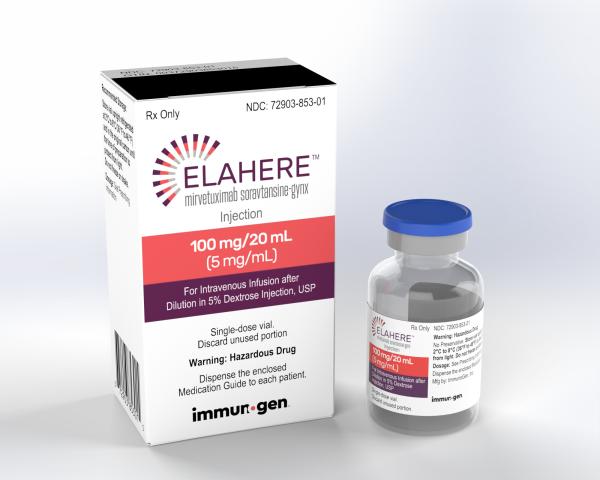Mirvetuximab Soravtansine Side Effects
Medically reviewed by Drugs.com. Last updated on May 26, 2024.
Applies to mirvetuximab soravtansine: intravenous solution.
Important warnings
This medicine can cause some serious health issues
Intravenous route (solution)
Warning: Ocular Toxicity. Mirvetuximab soravtansine-gynx can cause severe ocular toxicities, including visual impairment, keratopathy, dry eye, photophobia, eye pain, and uveitis.Conduct an ophthalmic exam including visual acuity and slit lamp exam prior to initiation of mirvetuximab soravtansine-gynx, every other cycle for the first 8 cycles, and as clinically indicated.Administer prophylactic artificial tears and ophthalmic topical steroids.Withhold mirvetuximab soravtansine-gynx for ocular toxicities until improvement and resume at the same or reduced dose.Discontinue mirvetuximab soravtansine-gynx for Grade 4 ocular toxicities.
Serious side effects
Along with its needed effects, mirvetuximab soravtansine may cause some unwanted effects. Although not all of these side effects may occur, if they do occur they may need medical attention.
Check with your doctor or nurse immediately if any of the following side effects occur while taking mirvetuximab soravtansine:
More common side effects
- black, tarry stools
- blindness
- blurred vision
- burning, numbness, tingling, or painful sensations
- change in vision
- chills
- cough
- decreased vision
- difficulty seeing at night
- double vision
- dry eye
- eye redness, irritation, or pain
- fever
- increased sensitivity of the eyes to sunlight
- lower back or side pain
- nausea
- painful, irritation of the clear front part of the eye
- painful or difficult urination
- pale skin
- seeing double
- severe constipation
- sore throat
- stomach pain
- trouble breathing
- ulcers, sores, or white spots in the mouth
- unsteadiness or awkwardness
- unusual bleeding or bruising
- unusual tiredness or weakness
- vomiting
- watering of the eyes
- weakness in the arms, hands, legs, or feet
Less common side effects
- bleeding gums
- blood in the urine or stools
- chest pain
- cough or hoarseness
- general feeling of discomfort or illness
- pinpoint red spots on the skin
- stomach bloating
- thickening of bronchial secretions
Other side effects
Some side effects of mirvetuximab soravtansine may occur that usually do not need medical attention. These side effects may go away during treatment as your body adjusts to the medicine. Also, your health care professional may be able to tell you about ways to prevent or reduce some of these side effects.
Check with your health care professional if any of the following side effects continue or are bothersome or if you have any questions about them:
More common side effects
- decreased appetite
- diarrhea
- muscle or joint pain
For healthcare professionals
Applies to mirvetuximab soravtansine: intravenous solution.
General adverse events
The most common adverse reactions with a frequency of 20% or more, including laboratory abnormalities, were vision impairment, fatigue, increased aspartate aminotransferase, nausea, increased alanine aminotransferase, keratopathy, abdominal pain, decreased lymphocytes, peripheral neuropathy, diarrhea, decreased albumin, constipation, increased alkaline phosphatase, dry eye, decreased magnesium, decreased leukocytes, decreased neutrophils, and decreased hemoglobin.
The most common side effects resulting in discontinuation were intestinal obstruction (2%) and thrombocytopenia (2%).
Serious adverse reactions were reported in 31% of patients, of which the most common were intestinal obstruction, ascites, infection, and pleural effusion.[Ref]
Gastrointestinal
- Very common (10% or more): Abdominal distension (11%), abdominal pain (36%), constipation (30%), diarrhea (31%), nausea (40%), vomiting (19%)[Ref]
Hematologic
- Common (1% to 10%): Thrombocytopenia[Ref]
Hypersensitivity
- Common (1% to 10%): Infusion related reactions/hypersensitivity[Ref]
Musculoskeletal
Nervous system
- Very common (10% or more): Peripheral neuropathy (33%)[Ref]
Ocular
- Very common (10% or more): Cataract (18%), dry eye (27%), eye pain (10%), keratopathy (37%), photophobia (17%), vision impairment (50%)
- Common (1% to 10%): Uveitis[Ref]
Other
- Very common (10% or more): Fatigue (49%)[Ref]
Respiratory
Metabolic
- Very common (10% or more): Decreased appetite (18%)[Ref]
References
1. (2022) "Product Information. Elahere (mirvetuximab soravtansine)." ImmunoGen, Inc., 1
More about mirvetuximab soravtansine
- Check interactions
- Compare alternatives
- Reviews (11)
- Dosage information
- During pregnancy
- Drug class: miscellaneous antineoplastics
- Breastfeeding
- En español
Patient resources
Other brands
Professional resources
Other brands
Related treatment guides
Further information
Mirvetuximab soravtansine side effects can vary depending on the individual. Always consult your healthcare provider to ensure the information displayed on this page applies to your personal circumstances.
Note: Medication side effects may be underreported. If you are experiencing side effects that are not listed, submit a report to the FDA by following this guide.

